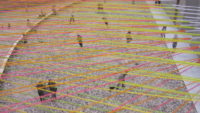Shuttling through time zones is second nature for Yichen Lu, the 39-year-old founder and principal of Studio Link-Arc. Lu—a Shanghai native who doubles as an associate professor at Tsinghua University in Beijing—spent this year bouncing between New York and China, with frequent stops in Italy to supervise the construction of the Milan Expo’s China Pavilion. But despite the firm’s global reach, each of its projects remains deeply local. Its aim is to build structures that foster dialogue between people and their natural surroundings. By weaving nature into the built environment, Studio Link-Arc aims to construct what Lu calls a “second nature” of its own.
“Nature, rather than man-made structures, is the eternal theme of architecture,” Lu says. This idea shone through every bamboo panel of the China Pavilion’s roof, a four-layer feat of digital fabrication and parametric design that hovered over a carefully paced sequence of spaces. The temporary pavilion was built for the six-month Milan Expo, which ended on October 31. However, the structure’s roof, which merged the profile of a city skyline with topographical curves, evoked the permanence of an urban landscape. The sun beamed through a translucent PVC membrane beneath the panels, casting shadows that stretched and shifted across the pavilion’s interior as the day passed. “It’s a building that can record time,” Lu says. Such fluid yet precise interactions with the elements occur at varying scales across Link-Arc’s portfolio, from renovations to new gallery spaces. In the firm’s current furnishings project for Milan’s 2016 Design Week, nature serves as an inspiration, as the team is experimenting with patterns and folds that mimic mountains and waves.
Lu likens the firm’s design process to the creation of a storyboard in film: in the China Pavilion as well as in its gallery projects, the transitions between one space and the next are carefully choreographed. Limiting the size of their buildings is crucial to the dance. Even with big residential developers in China, the firm commits only to projects at fewer than 100,000 square feet in size. With high-rises shooting up all over the country, staying relatively small creates “a lot of economic pressure,” Lu says, but the 15-person firm remains adamant about building on a limited scale at a careful pace.
After earning his undergraduate degree from Tsinghua University and his M.Arch. at Yale, Lu worked for Yung Ho Chang at Atelier FCJZ—China’s first independently licensed firm. According to Lu, Chang’s aim was to “redefine contemporary architecture in China” and to promote dialogue between Chinese architects and the rest of the world. Inspired by Chang to think globally, Lu spent two years working for Frank Gehry, his Yale advisor, on the Guggenheim Abu Dhabi, and then spent another two years as a project manager in China for Steven Holl before opening his own office in 2012. At both firms, Lu gained experience with cultural projects, which make up most of Studio Link-Arc’s work, but he hopes to expand his portfolio to include schools and more commercial projects.
Currently, the firm is working on a roof terrace atop a residential building in Manhattan, a library in Shenzhen, and several competition entries across Europe. Says Lu, “Traveling keeps us sharp to our surroundings and to cultural differences.”


















Post a comment to this article
Report Abusive Comment